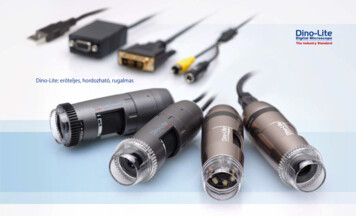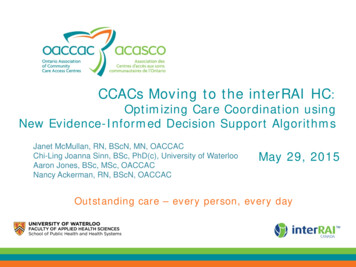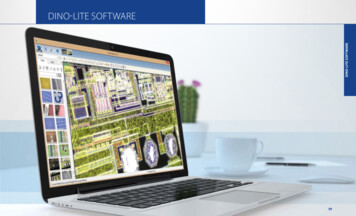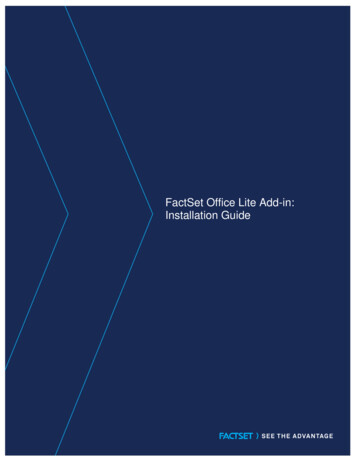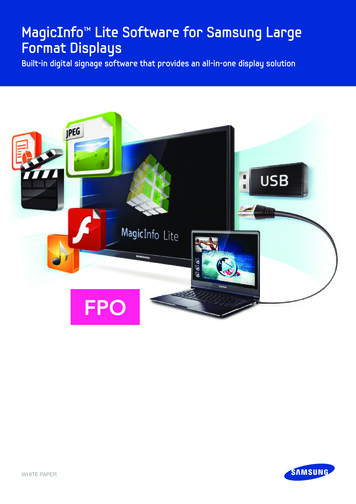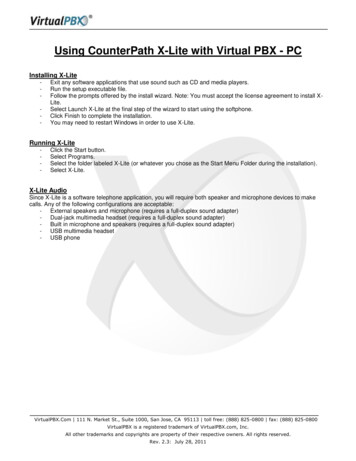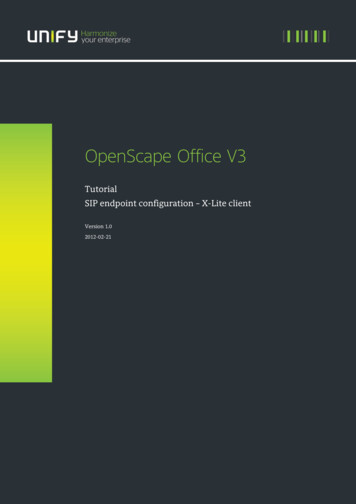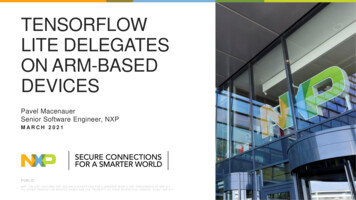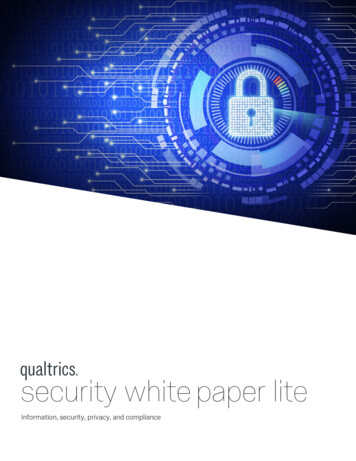
Transcription
security white paper liteInformation, security, privacy, and compliance
OVERVIEW OF OPERATIONS3Security governance13Definitions3Site operations14Platform data4Corporate offices14Control environment5Qualtrics responsibilities (data centers)14Risk management5Systems monitoring15Monitoring5Third party management15Information and communications5Training and awareness15Control activities5Vulnerability management16Business continuity & disaster recovery6Using the service17Change management7User controls19Data management8Privacy Appendix21Endpoint protection9General operations11Identity and access management11Incident response12Network operations12People operations13October 2018 - Version 7.0For Confidential Distribution Only2
Overview of operationsQualtrics is a Software-as-a-Service (SaaS) who provides a platform for creating and distributing online surveys,performing employee evaluations, web site intercepts, and other research services, refer to as the XM Platform. TheXM Platform records response data, performs analysis, and produces reports on the data. All services are online andrequire no downloadable software. Only modern JavaScript-enabled internet browsers and an internet connectionare required. Qualtrics offers multiple products for online data collection: Research Core, Vocalize, CustomerExperience, Employee Experience, Product Experience, and others. Services include providing the products andtechnical support. Surveys are usually taken online within a web browser, with optional SMS surveys and offlinemethods available for smartphones/tablets.DefinitionsThroughout this document, “Data” means information entered by a survey respondent, User (survey creator), or theinformation generated by Customers within the Qualtrics platform. A “Brand Administrator” is the account managerof the Customer account. A “User” is a Brand end-user with a Qualtrics login to create, report on, and send surveys,or otherwise utilize the software (a Brand Administrator is also a User). An “Account” is specific to a User, and acollection of Accounts reside under the “Brand.” A “Respondent” is an individual who responds to surveys created bya User. “Responses” are Data collected from surveys taken in web browsers on computer or mobile platforms, or viaSMS. A “Customer” means an organization that has a business relationship with Qualtrics. “Services” refers to therange of services provided by Qualtrics, including the software, email, support, and online resources. “QUni” refers tothe Qualtrics University—the support department—that includes a specialized team called “Customer Success.”October 2018 - Version 7.0For Confidential Distribution Only3
Platform dataAll Data is owned and controlled by Qualtrics’ Customers, who are designated as data controllers. Qualtrics is thedata processor. All Data is stored and processed in a single multi-tenant data center and in a single region (e.g. EU,US, Canada, Australia) chosen by the Customer. No Data is transferred outside of that region. In all data centers,Qualtrics solely operates and is responsible for all system and developed software.Qualtrics only processes Data to the extent necessary to provide the software and services, and does not discloseany Data to third parties. Qualtrics treats all Data as highly confidential, and promises to safeguard Data as it wouldits own.Customers determine the following about the data stored in the Qualtrics platform:Which type of data to collectWho to collect data fromWhere to collect dataWhat purposeWhen to delete the dataQualtrics cannot classify or represent the Data. All Data is treated as highly confidential and is processed equallyregardless of their meaning or intent. The foundation of our security is based on many industry standards,including National Institute of Technology Special (NIST) Publication 800-53 Rev. 4, International Organization forStandardization (ISO) 27001, and FedRAMP.October 2018 - Version 7.0For Confidential Distribution Only4
Control environmentExecutive management has set the tone at the top, which emphasizes the importance of well-designed and operatedsecurity controls. Management takes seriously control deficiencies identified in internal and/or external auditreports and takes full responsibility for remediation activities.Risk managementQualtrics conducts an annual assessment to identify, manage, and respond to risks to the organization. The assessmentprocess is based on the NIST Framework where threats and vulnerabilities are mapped to different asset classeswithin the organization.MonitoringQualtrics has implemented a company-wide information security management system to comply with therequirements associated with International Standards Organization, the Federal Risk and Authorization ManagementProgram (FedRAMP) (for the dedicated government environment), and other best practices. This program ismonitored by the Security Governance Committee and audited by independent third-party assessors who attest tocompliance to these standards.Information and communicationsQualtrics maintains internal information security policies and standards to ensure that employees understand theirindividual roles and responsibilities regarding security, availability, confidentiality, and significant events. The SecurityGovernance Committee is responsible for the overall security of Qualtrics. They coordinate formal and informaltraining programs, annual security awareness training, the security champion program, and other communication.An on-call team provides 24/7 monitoring and support to address issues in an efficient manner.Control activitiesQualtrics has established a comprehensive set of controls that were designed to meet various security frameworks.Qualtrics has organized these controls in the following domains, with a description of each control in the defined section.October 2018 - Version 7.0For Confidential Distribution Only5
Business continuity & disaster recoveryBUSINESS CONTINUITY PLANQualtrics has an extensive Business continuity plan (BCP) in event of a disaster. Though details of the plan areinternal only, below is a summary of how key business operations will operate following a disaster.Purpose: The purpose of this business continuity plan is to ensure prompt and complete return to normalcy in theevent of a service-affecting disaster.Goals and Objectives: The objectives of this plan are to ensure that, in the event of a disaster all necessary supportfunctions of the organization continue without undue delay. Data integrity and availability along with necessarysupport functions within the organization enable Qualtrics to maintain a trusting relationship with our Customerseven in times of disasters.Remediation: Testing the BCP is performed at least twice per year. Any significant findings are collected, and areport is produced for Engineering, TechOps, and InfoSec teams to review and create steps necessary to performthe test again and obtain a positive result. The VP of Engineering and other teams are also involved in the process.All business continuity activities are coordinated with input from team leads and managers.Communication: Transparent communication, coupled with complete infrastructure/Systems redundancy, ensuresuccessful continuity in times of disaster.DISASTER RECOVERY PLANSQualtrics has an extensive Disaster Recovery Plan (DRP) that the company will follow in the event of a disaster thatwould affect Data or the Services. A detailed internal document is used by engineers that contains specific detailsaround building, testing, and responding to disasters. Below is a high-level summary of activities:1.Preventative Measures: Preventative measures are currently in place at off-site data centers to minimize the2.IT Director Notification: In the event of an emergency at off-site or on-site data centers, the IT manager willeffects of a disaster.receive automatic notification via phone and email.3. Company Directors Notification: If the emergency affects operations, the Qualtrics executive staff will be notified.4.Relocation of Operations: All systems used to provide the Services are located in secure data centers and areaccessed remotely. Alternate data centers provide redundancy in case of a catastrophic data center failure.Internal operations could be temporarily relocated if necessary, and some employees could work from home orshared office.5.Customer Notification: Customers will be notified by email, telephone, and/or by the web site login page withthe details of the emergency. Additional information is located at www.qualtrics.com/status.EXTERNAL NOTIFICATION PROCEDURESCustomers will be notified by email, telephone, and/or by the web site login page with the details of the emergency.Additional information is located at www.qualtrics.com/status.BUSINESS CONTINUITY AND DISASTER RECOVERY PLAN TESTINGBusiness Continuity and Disaster Recovery plans are tested bi-annually.October 2018 - Version 7.0For Confidential Distribution Only6
Change managementDEVELOPMENT METHODOLOGYQualtrics uses an agile development model. This means that we take an iterative approach to software developmentand remain nimble in responding to the needs of our customers. Code is released on a two-week cycle that includesnew features, bug fixes, and upgrades.Each cycle includes comprehensive security checks to ensure that the code is vulnerability free. These checksinclude automated software assessments, peer, and managerial reviews. The Software Development Life Cycle(SDLC) is shown below in the diagram. Sometimes this is referred to as “change and release control.”DevelopmentPlanning stagesOctober 2018 - Version 7.0Review stagesFigure 1. Development MethodologyFor Confidential Distribution Only7
SEGREGATION OF DUTIESThere are many distinct Qualtrics programming teams and each team is responsible for specific areas of the code.Prior to any code deployments, code must go through the peer review process and identified issues must be addressed.Segregation of duties is achieved by ensuring that all code is reviewed and approved by different individuals.October 2018 - Version 7.0For Confidential Distribution Only8
Data managementDATA CLASSIFICATIONCustomers own and control all Data entered in or collected by Qualtrics Services. This includes survey definitions,responses, panels, uploaded content such as graphics, and derivative reports/analyses from responses. Qualtrics onlyprocesses Data to provide the Services.Qualtrics treats all Data as highly confidential, and promises to safeguard Data as it would its own.ENCRYPTION OF DATA IN TRANSITAll access to Qualtrics front-end Services is via Hypertext Transfer Protocol Secure (HTTPS) and enforces HTTPStrict Transport Security (HSTS). The platform supports Transport Layer Security (TLS) for all interaction withthe platform. Access to the back-end services using the Qualtrics API supports TLS v1.2. Data is processed byapplication servers and sent to database servers for storage. Respondent Data includes survey questions, graphics,and other content created in the survey design.ENCRYPTION OF DATA AT RESTIn the US, EU, and Asia, disk level encryption is standard for Data stored on the platform. Data at rest uses AES256-bit encryption. Unique keys are generated per server or data storage volume. Encryption keys are stored withina software vault where they are encrypted with key encrypting keys of equivalent strength. Keys are rotatedwhenever data storage volumes are rebuilt.DATA ISOLATION ENCRYPTION (PREMIUM FEATURE)As a premium feature, Qualtrics offers the Data Isolation product on the application. Data Isolation is application ordatabase level encryption using AES 256-bit cipher. Data Isolation encrypts response data with a data encryptingkey (DEK). The DEK is unique per survey. The DEK is encrypted using a Customer specific master key or keyencrypting key (KEK). The KEK is stored in Amazon Web Services’ Key Management Service. For additionalinformation, see the Data Isolation Data Sheet.October 2018 - Version 7.0For Confidential Distribution Only9
Endpoint protectionQualtrics has policies that describe controls for desktops, servers, and network hardware. These policies aredesigned from the start to provide the maximum level of security for the intended use of the device.DESKTOP POLICIESEach component of our infrastructure (operating systems, desktops, routers, servers), both internal and in the datacenters, have baselines that include security settings and default applications. This section applies to the desktopsand laptops (collectively, Workstations) used by Qualtrics employees.FULL DISK ENCRYPTIONAll Workstations require full disk encryption. Filevault is used and is enforced through a centralizedmanagement configuration.CLEAN DESK POLICYA Clean Desk policy has been established to define how data should be viewed on a screen and handled in hardcopy form. Any confidential documents in printed form must be securely locked or securely destroyed. Workstationpolicies define screensaver policies (lockout after 10 minutes).MOBILE POLICYQualtrics employees own their mobile devices (phone/tablet). If company email will be accessed from that mobiledevice, there must be a PIN to unlock the device and a timeout (sleep) value of five minutes or less. New PINs arerequired every six months. No Customer Data are accessible from mobile devices.October 2018 - Version 7.0For Confidential Distribution Only10
General operationsThe Qualtrics online privacy policy covers the use and disclosure of personal information that may be collectedanytime a user interacts with Qualtrics. Such interactions include visiting any of our web sites, using the Services, orwhen calling our sales and support departments. A detailed privacy statement is found at the www.qualtrics.com. Inaddition, the Terms of Service state acceptable policies regarding using the Qualtrics Services.INFORMATION COLLECTED IN THE NORMAL COURSE OF BUSINESSQualtrics does not sell or make available any information about our Customers (such as testimonials) or theirData without the Customer’s express permission, or per contractual agreement (such as testimonials). At notime will Qualtrics voluntarily disclose Customer information without a court order or the consent of theCustomer. We maintain a database of user information, which is used only for internal purposes, such astechnical support and notification of changes to the Service.CUSTOMER SUPPORTQualtrics University (QUni or technical support) staff may ask for personal information before accessing a User’saccount to confirm the Users identity. However, they will never ask for a User’s password. Passwords are saltedhashed values and not viewable by any Qualtrics employee. With the User’s permission, QUni may access an accountto assist in supporting the User or to diagnose a software problem. Such access may be disabled by the BrandAdministrator; doing so may result in decreased support quality.Identity and access managementFormal policies and procedures have been documented that define the requirements for provisioning anddeprovisioning of access to Qualtrics systems. Qualtrics follows the principle of least privilege when assigningaccess rights to use.PRODUCTION ACCOUNT PROVISIONINGAccess to Customer accounts is only given to those with a legitimate business need and with explicit approval.This includes members of the Qualtrics support teams (QUni and Client Success), engineering team for specific debuggingissues, and select members of our onboarding team that handle creating accounts for new customers. All system andservice logins are logged. No employee has unfettered access to Customer Data.TERMINATIONS: ACCOUNT DE-PROVISIONINGAs soon as specific access to systems/services/software is no longer required for job responsibilities, it is revoked.This includes termination of employment as well as changes to roles or responsibilities in the company.October 2018 - Version 7.0For Confidential Distribution Only11
Incident responseAn incident in this section refers to any discovery of deliberate or accidental mishandling of Data (collectively, an“Incident”). A detailed incident response policy is maintained by the InfoSec and Legal departments.INCIDENT RESPONSE PLANQualtrics has developed Incident Response policies and procedures to ensure the integrity, confidentiality, andavailability of the Data. These policies and procedures are consistent with applicable federal laws, Executive Orders,directives, regulations, standards, and guidance and are set forth by the management teams in compliance with theIncident Response family of controls found in NIST SP 800-53.An Incident includes:A malfunction, disruption, or unlawful use of the Service;The loss or theft of Data from the Service;Unauthorized access to Data, information storage, or a computer system; orMaterial delays or the inability to use the ServiceAny event that triggers privacy notification rules, even if such an event is not due to Qualtrics’ actions or inactionsDATA BREACH NOTIFICATION REQUIREMENTSAn Incident involving personal data (as defined by applicable regulations or laws) may require certain notificationprocedures. Qualtrics has suitable policies to handle these requests, and has a team of outside attorneys, privacy staff,and security experts to respond to the particular notification needs based on the content disclosed.Network operationsThe multi-tiered architecture has multiple layers of hardware and software security to ensure that no device/user can be inserted into the communication channel. Email may be configured to use opportunistic TLS to sendencrypted messages to an external email server, or as a relay to the Customer’s email server. Qualtrics leveragesa Web Application Firewall to prevent DDoS attacks. The Qualtrics Security Operations Center provides 24/7/365monitoring of network traffic and responds to DDoS attacks by identifying Botnet traffic.All access to Qualtrics front-end Services is via HTTPS and enforces HSTS. The platform supports TLS for allinteraction with the platform. Access to the back-end services using the Qualtrics API supports TLS v1.2. Datais processed by application servers and sent to database servers for storage. Respondent Data includes surveyquestions, graphics, and other content created in the survey design.Users access the Qualtrics platform with login credentials using a web browser. Customers may choose to authenticateby linking their Single Sign-On (SSO) system to Qualtrics. If SSO is not used, Brand Administrators have full controlover Users and the password policy.October 2018 - Version 7.0For Confidential Distribution Only12
People operationsQualtrics’ rapid growth requires an influx of great talent. All new hires are held to rigorous standards and musthave high qualifications. Qualtrics also requires background checks and adherence to strict privacy guidelines.Qualtrics is an equal opportunity employer.BACKGROUND SCREENINGTo the extent permitted by local law, employment offers at Qualtrics are extended contingent upon satisfactorycompletion of a background check. Background checks may include verification of any information on the offeree’sresume or application form.Security governanceINFORMATION SECURITY MANAGEMENT SYSTEMThe Information Security Management System (ISMS) defines the overall security function at Qualtrics. The ISMSincludes policies, procedures, and standards that define the controls that help support the confidentiality, integrity,and availability of the XM Platform. Additionally, the ISMS outlines the roles and responsibilities of employees atQualtrics to help protect the confidentiality, integrity, and availability of the platform.SECURITY CERTIFICATIONSIn order to demonstrate Qualtrics’ commitment to Information Security, they have implemented a Security Assuranceprogram to obtain and maintain security certifications. Qualtrics has the following security certifications:ISO 27001Security Management ControlsOctober 2018 - Version 7.0FEDRAMPGovernment Data Standards(Moderate)CYBER ESSENTIALSCyber Threat ProtectionFor Confidential Distribution Only13
Site operationsQualtrics is responsible for the physical security controls at the Corporate offices, and components of physicalsecurity controls within the co-location data centers. Physical security controls of the colocation data center are theresponsibility of the data center service provider. The controls are monitored annually through onsite visits and thereview of third-party audit reports.Corporate officesSECURED FACILITYPhysical access to the facility and computer equipment located at corporate facilities is managed through the use ofbadge readers at all entry and exit points. The badge system is configured to log all card swipes. The badge system isconfigured to alert if doors are forced or if doors are held open for an extended period of time. Video surveillance isrecorded and maintained for a minimum of 30 days to allow for a review.Qualtrics responsibilities (data centers)DATA CENTERSQualtrics leases space in five colocation data centers. Qualtrics owns and operates all server and network devices. Datacenter personnel have no authorization to access Data or the underlying software environment (as per contractualagreement and confirmed by independent audits).In general, all data centers utilized by Qualtrics:are in non-descript buildingsaccess controls to all areas (including loading dock) using biometrics and card readerslog and monitor all entry and exit accesshave 24/7 on-site guardsconstantly monitor power, fire, flood, temperature, and humiditygeographically diverseData centers are audited using industry best practices. Detailed reports may be requested by existingCustomers either from Qualtrics with a signed confidentiality agreement.October 2018 - Version 7.0For Confidential Distribution Only14
Systems monitoringVarious tools are used to monitor the confidentiality, integrity, availability, and performance of the production environment,such as intrusion detection systems, performance and health systems, and security event correlation systems.Third party managementTHIRD PARTY DUE DILIGENCETo help mitigate risk to Qualtrics and our customers, the Security Assurance team performs regular reviews ofsuppliers and the services they provide. The Supplier Risk Assessment process evaluates suppliers based on aninternal and external risk score. The internal risk score is based on types of data that will be stored, where the datawill be stored, and how it would be accessed. The external risk score is calculated based on responses and evidenceprovided by the supplier. Control areas reviewed include but not limited to: information security, logical access,physical security, vulnerability management, change management, data security, and data privacy.Training and awarenessGENERAL SECURITY AWARENESS TRAININGQualtrics employees are formally trained on company policies and security practices. This training occurs at the timeof hire and at least annually through in-person or online for remote employees. In addition to the in-person trainings,regular updates are provided throughout the year through email, intranet postings, and regular company meetings. Allemployees are instructed to immediately report possible security incidents to their manager, InfoSec, and Legal. Thecomputer security section of the employee manual includes the following topics:Privacy law compliancePersonal devices in the companyPhysical securityInformation Security IncidentsEmail acceptable use policyPassword policy and tipsAccess controlInsider threatInternet securityOctober 2018 - Version 7.0For Confidential Distribution Only15
Vulnerability managementPATCH MANAGEMENTPatch management is performed whenever a new core set of software is to be deployed. Patches are fully testedand deployed as soon as practical, based on their impact. Systems which require patching are typically detected aspart of vulnerability scans, however, Qualtrics Engineering team members also subscribe to security advisories forthe technologies used and will receive notification when patches are released.PENETRATION TESTINGExternal security assessments are performed by an independent third-party. Penetration tests against theproduction environment are performed annually. Remediation plans are documented to address findings from thereport. Findings and remediation plans are presented to the Security Governance Committee and tracked untilthey’ve been addressed.Qualtrics maintains an internal penetration team that is continuously testing elements of the applications lookingfor bugs. Similar to external tests, findings are presented to the Security Governance Committee for their review.VULNERABILITY SCANSExternal and internal vulnerability scans are run regularly against the production environment. Vulnerabilityscanning tools are configured to update their definition regularly and scans the environment to identify missingpatches and other misconfigurations. Patches are applied based on the overall risk rating.October 2018 - Version 7.0For Confidential Distribution Only16
Using the serviceThis section is specific to Customers and their Users using the Qualtrics platform—the products and Services.BRAND ROLESThese roles are found within Qualtrics products. More details may be found in the University (support) section at theQualtrics web site.User: A person that has access to the platform for creating and distributing surveys, as well as viewing andanalyzing data, as allowed by the role permissions. Multiple User roles may be created with varied permissions.Brand Administrator: A Brand is an account with one or more Users. A Brand Administrator has permissionsto login as any user within the Brand, as well as restrict the permissions of any other User in the Brand. BrandAdministrators also have access to other administrative tools, such as a password reset function. This role is assigned bythe Qualtrics onboarding team, and thereafter all Brand control is under the full control of the Brand Administrator.ACCOUNT ACCESS CONTROL FOR THE SERVICEThe Qualtrics user who owns the survey: This is the person who creates the survey. Ownership of a survey canalso be transferred by a Brand Administrator. Login access is recorded for each user account.Members of a group that owns a survey: Qualtrics supports an organizational unit called a Group. Groups are usedfor collaborative processes and a Group (that may contain several users within the Brand) may be designated asthe owner of a survey. Members of Groups are granted privileges to view Data associated with them. A Divisionmay contain a collection of Groups and Users, with a Division Administrator.Collaboration: Individual surveys may be collaborated (or shared) with other Users or Groups. Whencollaborating, a User can specify which permissions other Users or Group Members should have, includingaccess to view associated Data. Access to collaboration functions may be restricted on a per-User basis. Also,survey distribution may be restricted until approved by a designated user.Brand Administrator: The Brand Administrator has full control over the Brand, and may log in to any User account withinthe Brand (the audit log will show that login).October 2018 - Version 7.0For Confidential Distribution Only17
PASSWORD POLICIES FOR THE SERVICESThis section applies to password policies available in the Qualtrics platform that, like other functions, are solely underthe control of the Brand Administrator.Qualtrics will never ask for a User password. All User passwords are hashed. Password settings available within theplatform include:Failed Attempts: In order to block unauthorized access through password guessing, accounts are disabled aftersix invalid login attempts. Once an account has been deactivated, the account stays deactivated for ten minutes(and reset each time a new login attempt is performed). The Brand Administrator may also reactivate the account.Password Complexity: Settings for length, complexity (non-alpha characters), and periodic password expirationare available at the Brand level. For more complex password requirements, SSO integration is recommended. Aunique error message may be sent when a password doesn’t meet the stated requirements.Password Expiration: Settings for expiration are define within the organization settings. The configuration is defined innumber of days. A unique error message may be sent when a password doesn’t meet the stated requirements.Forgotten Password Policy: If a user forgets their password, or makes more than six invalid login attempts (causingtheir account to become deactivated), they may call Qualtrics support for help. There is also an optional self-servicepassword reset option that sends an email with a link to create a new password.Single Sign-On: SSO allows Customers to better control user management (additions/deletions) from theCustomer’s directory service, directly linked to the Qualtrics authentication service. Industry standard protocolsare supported, including LDAP, CAS (Central Authentication Service), Google OAuth 2.0, Token, Facebook, andShibboleth (SAML).These settings are controlled within the Advance Security Tab.See sp-administration/security-tab/ for more details.SURVEY SECURITY AND USAGEThere are several ways to protect surveys from being “stuffed,” or from being taken by the wrong respondent.Full details are available on the Qualtrics support web site. Surveys may be sent to specific individuals, require apassword, or be taken only by Customer employees. It’s up to the Users to determine who should take the survey andwhat content should be collected. Survey links may be posted on a web page, sent in email, or printed on paper anddelivered via certified mail.Brand Administrators control the brand, in
Qualtrics has established a comprehensive set of controls that were designed to meet various security frameworks. Qualtrics has organized these controls in the following domains, with a description of each control in the defined section. -Version 7.0 For Confidential Distribution OnlyOctober 2018 6
